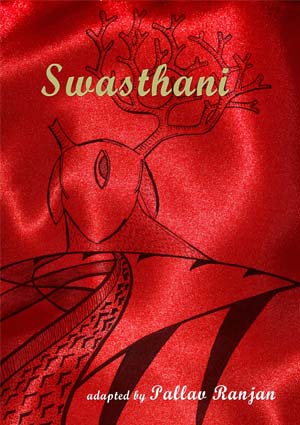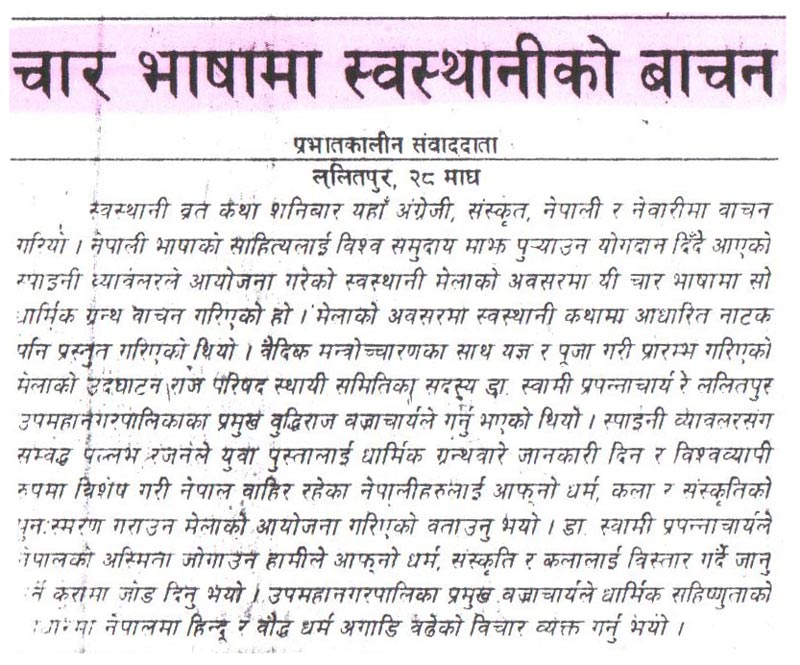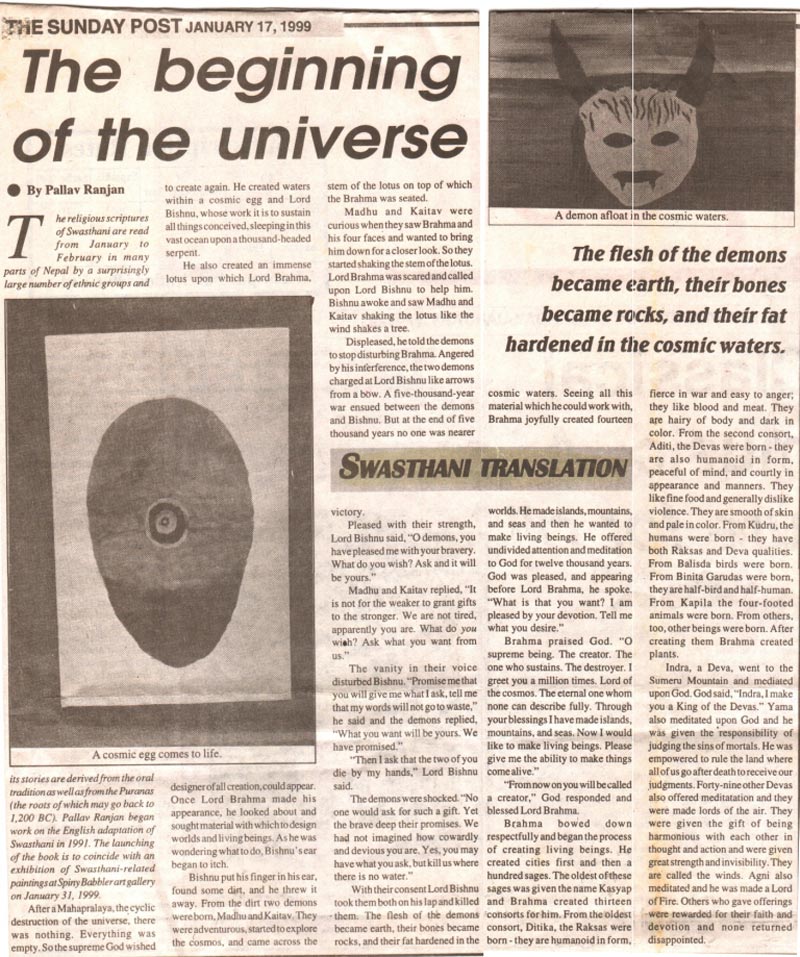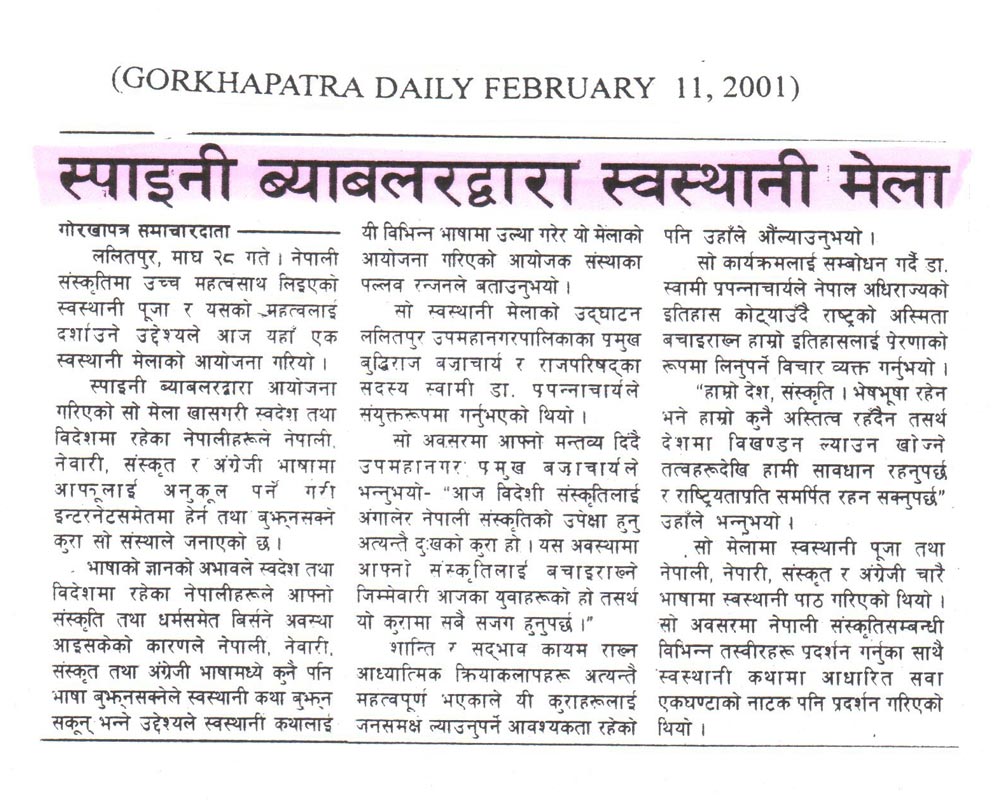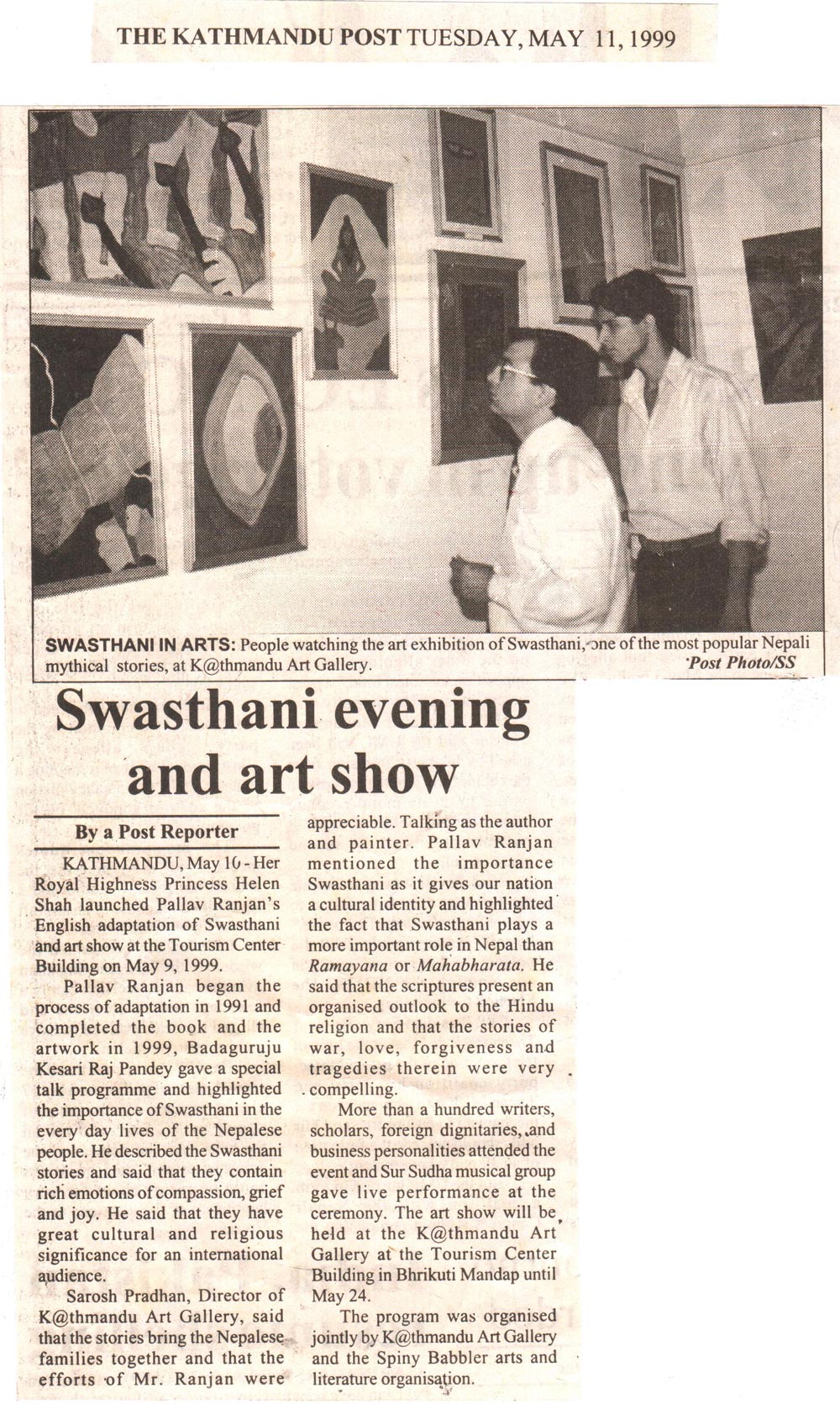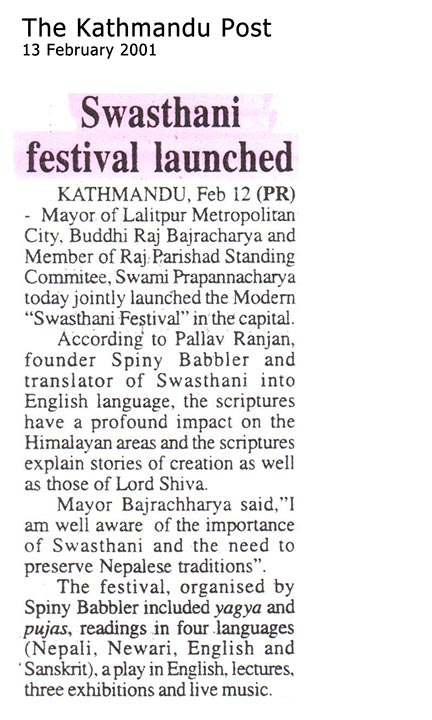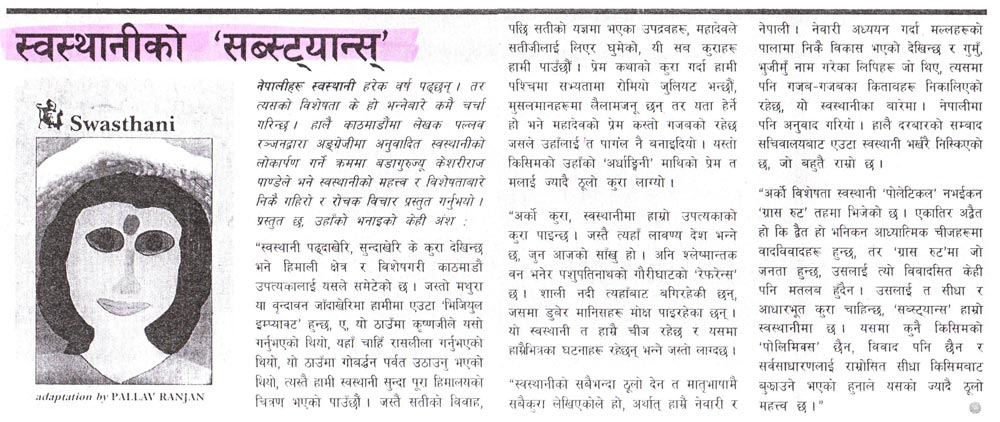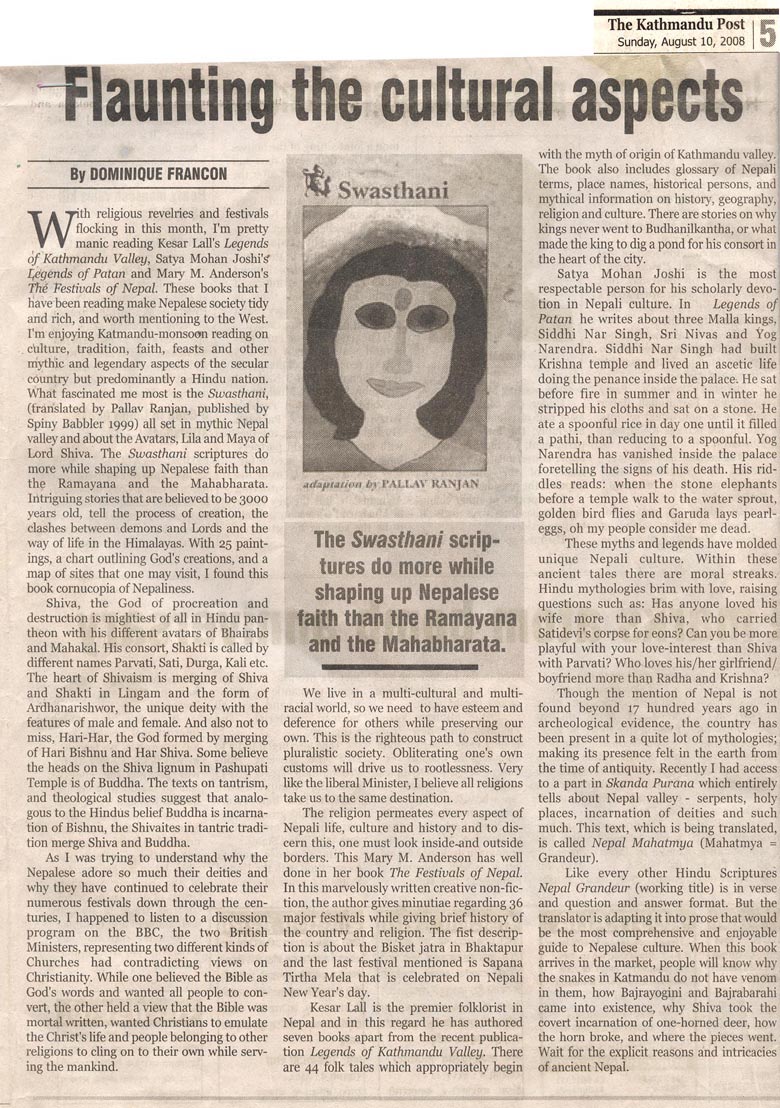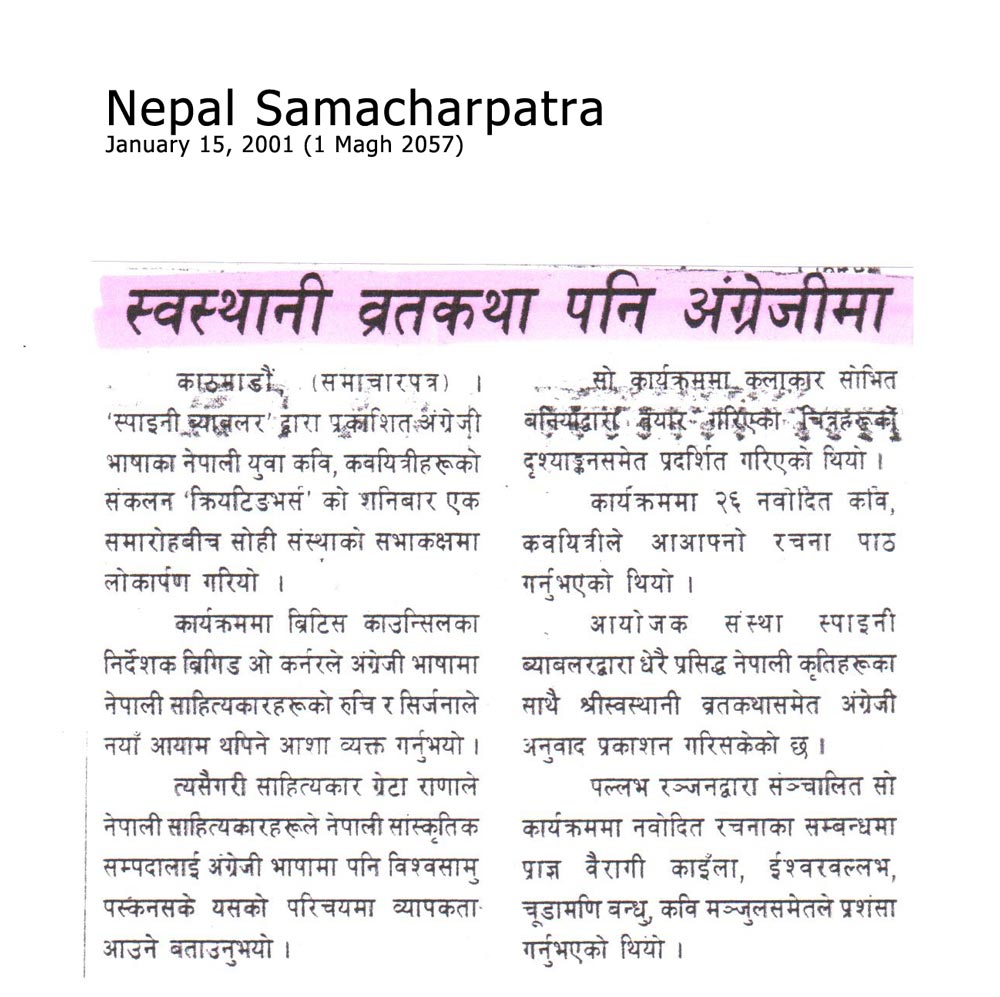Content
- “Swasthani in Four Languages.” Nepali language only. Prabhatkalin. Lalitpur, Nepal. View
- “Musings from an American-Nepali Household: Swasthani.” americanepali.wordpress.com. US. View
- “The Beginning of the Universe.” The Sunday Post. 17 January 1999. Kathmandu, Nepal. View
- “Spiny Babbler Organizes Swasthani Mela.” Gorakhapatra. 11 February 2001. Kathmandu, Nepal. View
- “Swasthani Evening and Art Show.” The Kathmandu Post. 11 May 1999. Kathmandu, Nepal. View
- “Swasthani Festival Launched.” The Kathmandu Post. 13 February 2001. Kathmandu, Nepal. View
- “Swasthani’s Substance.” Himal. Laliptur, Nepal. View
- Francon, Dominique. “Flaunting the Cultural Aspects.” The Kathmandu Post. 10 August 2008. View
- “Swasthani Vrata Katha Also in English.” Nepal Samacharpatra. 15 January 2001. Kathmandu. View
- Hutt, Michael. “Swasthani Adaptation by Pallav Ranjan.” EBHR. SOAS. London, UK. View
Musings from an American-Nepali Household
Swasthani
Posted on January 25, 2011 | 21 Comments
https://americanepali.wordpress.com/2011/01/25/swasthani
Last week’s full moon marked the beginning of a new month in the Nepali calendar. One of the rituals of this month is the reading of a book of Hindu mythology called “Swasthani.” As mentioned before—even after 7 years of knowing P, there are always bits of culture that I am picking up along the way—and Swasthani is one such new piece.
I was introduced to Swasthani a few months ago when I saw an English language edition on S-di’s bookshelf. I didn’t know the significance of the book, but asked if I could take it home to read. Inevitably it wound up on my pile of “to read” books, and there it sat.
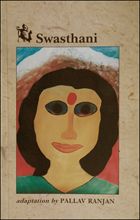
Then last week P and D were talking about the reading of Swasthani (unusual—since neither ever talk about reading, conversations are more often about soccer, drinking tea, or eating). It piqued my interests.
Apparently in households across Nepal, starting on the full moon during Poush/Magh, families celebrate by sitting together each evening, reading a passage from Swasthani and conducting a puja. P seemed excited about this, recalling memories of sitting with his family reading passages from the book on cold winter evenings. He even found a website where individuals could listen to passages from the book if you don’t have a copy abroad.
As the voracious reader of our family, I was enthusiastically ready to embrace a ritual which involves the family coming together each night to read. I googled Swasthani and realized that the book was the same as the English language book S-di let me borrow months earlier. So I told P, let’s do it.
Each evening for the past few days I’ve been laying a table cloth on the living room floor, lighting a few tea lights, and occasionally an incense stick, gathering a few fruits and a carnation flower. P and I sit on the floor (we even get our dog to sit with us, he is part of the household). P will pass out bits of the carnation flower, open the book and read the first passage (a prayer in Sanskrit), then I’ll take the book, read the story for the day in English, then hand the book back for P to read the closing prayer in Sanskrit. We put the carnation pieces in the book and the petals each day are pressed between the pages. Later on we make smoothies out of the puja fruit to drink with dinner.
I enjoy it, because I like hearing stories, many of which I have not heard before. P enjoys it because it reminds him of reading the stories back home. He even knows the prayers to say at the beginning and end of the readings by heart, something I’ve never seen him do before. The English copy that I have only has 22 stories, in abbreviated form, whereas the Nepali versions from P’s childhood have 31 readings and are usually much longer and more detailed. If anyone is interested in reading the stories, let me know (since the book is not available in the US).
EBHR 17
Page 159-161
Swasthani adaptation by Pallav Ranjan
Kathmandu. Spiny Babbler, 1999. 126 pp.
Reviewed by Michael Hutt
Pallav Ranjan divides his English adaptation of the Swasthani Vrat Katha, the 'Story of the Fast of the Goddess Swasthani', into twenty-two short 'readings'. Two thirds of these deal with characters and myths from the Hindu Puranas. Readings 1 and 2 deal with cosmology and the creation of the world. The main theme of readings 3 to 7 is the story of Shiva's marriage to Satidevi, daughter of Daksya Prajapati, Daksya's insulting of Shiva, Satidevi's self immolation, and Shiva's mourning and scattering of the pieces of Satidevi's body, during which the demon Taraka takes over the world. Readings 8 to 15 begin with the birth of Parbati, who manages to secure Shiva as her husband by reading the Swasthani stories, and go on to recount the myths of Shiva as Kirateswor in the forest near Pashupati, the births and exploits of Ganesh and Kumar, the defeats first of Taraka and then of the demons who had created Three Cities, and the bizarre series of seduction, murder, and suicide involving Bishnu and Shiva, and Jalandhar and his wife, Brinda.
Finally, readings 16 to 22 contain the story of Goma, the girl who is cursed by Shiva to marry a man ten times her age. This is in some way the most interesting section of the text. At the age of seven, Goma marries a 70-year-old man, Shivasharma, and they live with her parents. Some years later Shivasharma decides he must go home, and Goma goes with him. As soon as they have departed, her parents die in an accident, and on their journey thieves steal everything from Shivasharma and Goma, then Goma becomes pregnant. When they reach Shivasharma's village he goes begging for food but dies in a fall. Goma bears a son, Nawaraj, and they are supported by some local rich people. In time, Nawaraj marries Chandrawati, then he searches and finds his father's bones but does not return to his mother. After a while Chandrawati goes back to her parents, leaving Goma alone. Goma goes mad, but Parbati sends Rishis to teach her the Swasthani rites, and when they leave she finds gold under their seats.
Goma's readings of the Swasthani stories bring her son back to her, and Shiva, now suddenly benevolent, sends Nawaraj to become king of Labhanya and take a new wife. Goma is summoned there too. Nawaraj holds a feast and magnanimously invites Chandrawati too, but on her way to Labhanya Chandrawati becomes angry with her bearers for stopping to listen to the Swasthani stories en route, and when they resume their journey she falls into a flooding river. Chandrawati is so evil that the river does not flow again until some villagers dump her body on the bank, where she becomes an unrecognizable object. Not even the soil will allow her to eat it. Two priests on their way to the feast promise to bring food back for her but the grain store suddenly empties when they go to get some, and the rice turns to ash when she tries to eat it. The Apsaras come and tell her to read the Swasthani and make offerings of sand; finally, she is restored to her family.
The Swasthani Vrat Katha is a crucial text for anyone who wishes to understand the ideals and constraints that have traditionally governed the lives of women (particularly, but not exclusively, Brahman and Chetri women) in Nepal. My understanding of it prior to reading Pallav Ranjan's rendering relied heavily on the summary and analysis that appear in Lynn Bennett's book Dangerous Wives and Sacred Sisters: Social and symbolic roles of high-caste women in Nepal (Columbia University Press, 1983, especially pp. 274-306). Bennett referred to an edition compiled by Babu Madhav Prasad Sharma and published in Banaras in 1955, which extends to around 300 pages. Pallav Ranjan's retelling of these stories is in almost flawless English and is highly readable. For instance, when Shivasharma hears Goma's mother, Sati, voicing her horror at the idea of her daughter marrying such an elderly man, the words Ranjan has him say are genuinely poignant:
“There are old people in this world, mother, and then there are children. There are people who are pleasant to look upon and people who are ugly. Some people do not have descendants and some have too many. Some have wives that are older than they are and some have husbands who are older. Some of us are rich and some poor. The world is like the potter's wheel. It is always spinning. Everyone becomes old and dies. There are none who will not age. Why do you feel that you are better than I am? Why will you not respect my life? If this is how you feel , I will die now, before your eyes.”
Parts of Ranjan's adaptation appear highly condensed in comparison with the edition cited by Bennett. For instance, Bennett quotes from her own translation of the episode towards the end of the Goma story, in which an Apsara instructs Chandrawati how to perform the Swasthani vow, and these instructions continue for 26 lines (Bennett 1983: 277), but Ranjan simply gives us "So she asked the Apsaras what she should do. According to their advice, Chandrawati learned to worship the Swasthani with a clean mind" (p. 118). Thus, it would seem that Ranjan has prepared his adaptation for a readership that would find this level of detail irrelevant and tiresome.
It would have been instructive if Pallav Ranjan had provided some insight in his brief preface into the way in which he prepared this adaptation. Certain passages are very close indeed to the original, which suggests that a text was at least consulted, while others are omitted (suggesting an intention to abridge, perhaps) or simply different (suggesting that a different text was consulted or that Ranjan relied on an oral source or his own memory) . It is also a shame that Ranjan's introduction does not really bring out the important role the text has played and continues to play in the lives of so many women in Nepal.
Which brings us to the question of readership. For whom is this 'adaptation' intended? Nepali readers with a mastery of English will admire the elegance of its prose, and will also appreciate this effort to bring this text to the attention of a wider readership. To introduce the text to a foreign readership which is unable to approach it in its original language: would be a worthy aim, but if this is indeed the intention the success of the initiative it is rather circumscribed by the absence of any real explanation or analysis of the text's precise significance and meaning, despite the fluency and accessibility of the English rendering itself. To fully understand what is going on here, a foreign reader would need also to be directed to a work like Bennett's.
This is not to detract from Pallav Ranjan's achievement, which is notable and worthy of praise. The text is also greatly enhanced by the inclusion of illustrations whose abstract nature suggests that they emanate from the same mythic dimension in which these stories take place.
SOAS • LONDON CNRS' PARIS SAl' HEIDELBERG
Note by Pallav Ranjan: Some of the ideas and suggestions offered in this review have been incorporated in the second edition of "Swasthani".
